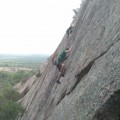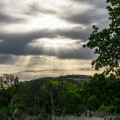The top ten pieces of rock climbing gear to own for a safe and enjoyable climb
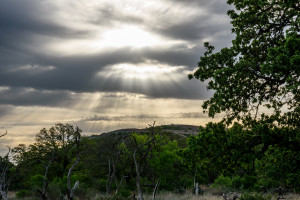
We recently asked James Faerber (Executive Director and co-owner of OWA as well as an incredible rock climbing guide) what he thought the 10 most important pieces of rock climbing gear to own were and his comprehensive list opened our eyes on what EXACTLY it takes to have a safe and enjoyable climb. This list is a compilation of his thoughts based on his experience and knowledge in the industry and from countless hours of climbing and testing products. He recommends the gear listed below but we need to make the disclaimer that you need to do your own independent research on any product in this industry as it is important that you are comfortable with your safety gear. James uses this rock climbing gear and this is what he recommends:
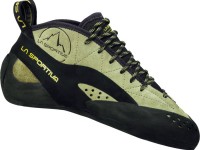 1. Rock Climbing Shoes– Most climbers will agree that having a good pair of rock shoes that are appropriate for the type of climbing you plan to do is the first thing you should buy when starting to purchase rock climbing gear. Picking out the right rock shoes can be a daunting task. Rock shoes should fit tight for better performance but be comfortable enough that you can actually wear them for a few routes (more on this later). There are several types of shoes with lots of minute changes and differences between different models. The first thing you want to figure out is the type of climbing and type of rock you will most likely be climbing. If the climbing you do varies between a lot of rock types and lengths of climbs then pick a more general shoe. If you primarily climb steep or pocketed routes, shoes with a downturned toe will be helpful. There are 2 major options for securing the shoes, laces and Velcro, personally I own both. My gym and sport climbing shoes are Velcro, they fit tight and I want to get them on and off quickly. My trad and multi-pitch shoes have laces and can be adjusted more whether I want them loose for a long day or cinched down tight for the crux (most difficult part of climb). My favorite shoes are the La Sportiva TC pros, I spent 3 months in Colorado last summer and these are the only shoes I took. Conversely I had 3 pairs of approach shoes; the TC pros are that good!
1. Rock Climbing Shoes– Most climbers will agree that having a good pair of rock shoes that are appropriate for the type of climbing you plan to do is the first thing you should buy when starting to purchase rock climbing gear. Picking out the right rock shoes can be a daunting task. Rock shoes should fit tight for better performance but be comfortable enough that you can actually wear them for a few routes (more on this later). There are several types of shoes with lots of minute changes and differences between different models. The first thing you want to figure out is the type of climbing and type of rock you will most likely be climbing. If the climbing you do varies between a lot of rock types and lengths of climbs then pick a more general shoe. If you primarily climb steep or pocketed routes, shoes with a downturned toe will be helpful. There are 2 major options for securing the shoes, laces and Velcro, personally I own both. My gym and sport climbing shoes are Velcro, they fit tight and I want to get them on and off quickly. My trad and multi-pitch shoes have laces and can be adjusted more whether I want them loose for a long day or cinched down tight for the crux (most difficult part of climb). My favorite shoes are the La Sportiva TC pros, I spent 3 months in Colorado last summer and these are the only shoes I took. Conversely I had 3 pairs of approach shoes; the TC pros are that good!
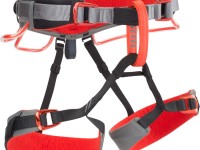 2. Climbing Harness– A good quality harness can make or break a climbing day; I like a reasonably simple harness with the key features and not a lot of extras. Several of the big manufacturers are now making harnesses with pre threaded buckles. These are my favorite. I use the Black Diamond Momentum DS, it has 2 pre threaded buckles on the waist belt for a lot of adjustability (I climb in a lot of different weather). The 2 buckles also make for quick on and off. The leg loops are also adjustable in case I am wearing layers or my thighs grow from cycling too much! Make sure you get one with a decent amount of padding and at least 4 gear loops.
2. Climbing Harness– A good quality harness can make or break a climbing day; I like a reasonably simple harness with the key features and not a lot of extras. Several of the big manufacturers are now making harnesses with pre threaded buckles. These are my favorite. I use the Black Diamond Momentum DS, it has 2 pre threaded buckles on the waist belt for a lot of adjustability (I climb in a lot of different weather). The 2 buckles also make for quick on and off. The leg loops are also adjustable in case I am wearing layers or my thighs grow from cycling too much! Make sure you get one with a decent amount of padding and at least 4 gear loops.
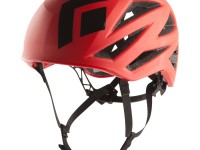 3. Helmet– A key piece of equipment that a lot of climbers skip. The new helmets are ultra light and stylish and will help protect you from both rock and other objects falling from above. They also will protect you if you bang your head in a fall of some sort. A lot of climbers forget how easy it is to hit your head in a climbing fall, even if the system is working correctly. My favorite is the Black Diamond Vapor. Like any helmet or other climbing gear, replace it when damaged or excessive wear occurs.
3. Helmet– A key piece of equipment that a lot of climbers skip. The new helmets are ultra light and stylish and will help protect you from both rock and other objects falling from above. They also will protect you if you bang your head in a fall of some sort. A lot of climbers forget how easy it is to hit your head in a climbing fall, even if the system is working correctly. My favorite is the Black Diamond Vapor. Like any helmet or other climbing gear, replace it when damaged or excessive wear occurs.
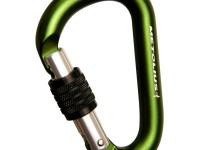 4. Locking Carabiners– an invaluable piece of gear that should be purchased when you start to climb since these little devices become your connection point. Go with locking ones first and pear shaped or HMS carabiner. These are used for connecting the belay device and rope to your harness, for building anchors, and for connecting yourself to the rock while cleaning a route or multi-pitch climbing. The Metolious Element Belay Carabiner is my favorite. The ultra light ones are useful but do have some limitations. I would buy 2-5 to begin with as that gives you enough for belaying and anchoring in most systems.
4. Locking Carabiners– an invaluable piece of gear that should be purchased when you start to climb since these little devices become your connection point. Go with locking ones first and pear shaped or HMS carabiner. These are used for connecting the belay device and rope to your harness, for building anchors, and for connecting yourself to the rock while cleaning a route or multi-pitch climbing. The Metolious Element Belay Carabiner is my favorite. The ultra light ones are useful but do have some limitations. I would buy 2-5 to begin with as that gives you enough for belaying and anchoring in most systems.
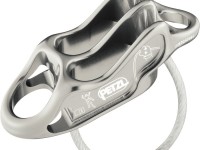 5. Belay and rappel device– a simple tubular style device will do the trick. The newer ones with extra grooves for stopping power are nice and the ones with a “guide mode” like the Petzl Reverso are key if you plan to multi-pitch or belay from above (they aren’t great for lowering so make sure you understand how they work). If you want to get a simple workhorse consider the Trango Pyramid. There are belay devices with “braking assist” functions that are really nice but more costly and complicated to use. I do have both a Petzl Gri Gri and a Trango cinch and love them for certain application I just wouldn’t recommend them as your first belay device. Go with the simple tubular model first and work your way up!
5. Belay and rappel device– a simple tubular style device will do the trick. The newer ones with extra grooves for stopping power are nice and the ones with a “guide mode” like the Petzl Reverso are key if you plan to multi-pitch or belay from above (they aren’t great for lowering so make sure you understand how they work). If you want to get a simple workhorse consider the Trango Pyramid. There are belay devices with “braking assist” functions that are really nice but more costly and complicated to use. I do have both a Petzl Gri Gri and a Trango cinch and love them for certain application I just wouldn’t recommend them as your first belay device. Go with the simple tubular model first and work your way up!
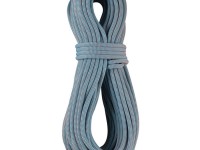 6. Rope-obviously an extremely important component of any climbing system. With improvements in technology, ropes have gotten thinner, more wear resistant and more expensive. A good standard rope is 60m in length and 9.8mm in diameter. You can go longer (70m) if you expect long rappels in a place like El Potrero Chico or go shorter (35m) if you climb in a place like central Texas where most routes are short. Whatever length you choose remember you have to haul that rope with you and it should be appropriate to the area(s) you climb in. I have found 9.8mm to be the ideal width for longevity, handling and weight. I do own thicker and thinner ropes 9.2-10.5 and some 8.2 half ropes but for most people a good quality 9.8mm diameter rope 60m in length will do just fine. I have a couple of Edelrid Boa ropes that are great! Don’t forget to inspect and replace if needed. Watch for sharp edges or crystals that can quickly damage a rope beyond use.
6. Rope-obviously an extremely important component of any climbing system. With improvements in technology, ropes have gotten thinner, more wear resistant and more expensive. A good standard rope is 60m in length and 9.8mm in diameter. You can go longer (70m) if you expect long rappels in a place like El Potrero Chico or go shorter (35m) if you climb in a place like central Texas where most routes are short. Whatever length you choose remember you have to haul that rope with you and it should be appropriate to the area(s) you climb in. I have found 9.8mm to be the ideal width for longevity, handling and weight. I do own thicker and thinner ropes 9.2-10.5 and some 8.2 half ropes but for most people a good quality 9.8mm diameter rope 60m in length will do just fine. I have a couple of Edelrid Boa ropes that are great! Don’t forget to inspect and replace if needed. Watch for sharp edges or crystals that can quickly damage a rope beyond use.
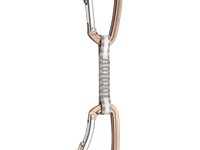 7. Quickdraws-an essential piece of gear for climbers learning to lead climb. Lead climbing is taking the rope up a route with you as you go placing gear or clipping bolts to catch you in case of a fall. Buying some quickdraws will allow you to begin leading routes that are bolted. A quickdraw is basically a very short sling with a carabiner on each end, one for clipping to the bolt the other to clip your rope to. I like thick sewn sling with basic carabiners like the Black Diamond Positron and Nitron on each end.
7. Quickdraws-an essential piece of gear for climbers learning to lead climb. Lead climbing is taking the rope up a route with you as you go placing gear or clipping bolts to catch you in case of a fall. Buying some quickdraws will allow you to begin leading routes that are bolted. A quickdraw is basically a very short sling with a carabiner on each end, one for clipping to the bolt the other to clip your rope to. I like thick sewn sling with basic carabiners like the Black Diamond Positron and Nitron on each end.
 8. Cams– cams are also used for lead climbing but can also be used to build an anchor for top roping. Cams are an active type of protection the climbers place in cracks, or other spaces between rocks and form a somewhat secure connection point to clip your rope or cord for building anchors. While using cams isn’t rocket science, it is an advanced technique that shouldn’t be taken lightly. Try to choose cams appropriate for the type of rock you climb in most often and the area your climb at. I like FIxe Aliens for small cracks, Black Diamond Camalots in the standard sizes, and Metolius fat cams for when I climb in soft rock. Your best bet is to ask a lot of the climbers in your local area what type of cams they prefer, why, and how many of each size they typically use. A professional and certified local guide service can also teach you how to place gear and build anchors.
8. Cams– cams are also used for lead climbing but can also be used to build an anchor for top roping. Cams are an active type of protection the climbers place in cracks, or other spaces between rocks and form a somewhat secure connection point to clip your rope or cord for building anchors. While using cams isn’t rocket science, it is an advanced technique that shouldn’t be taken lightly. Try to choose cams appropriate for the type of rock you climb in most often and the area your climb at. I like FIxe Aliens for small cracks, Black Diamond Camalots in the standard sizes, and Metolius fat cams for when I climb in soft rock. Your best bet is to ask a lot of the climbers in your local area what type of cams they prefer, why, and how many of each size they typically use. A professional and certified local guide service can also teach you how to place gear and build anchors.
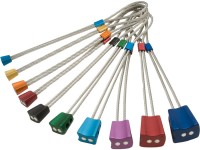 9. Nuts– nuts are similar to cams but are a type of passive protection (no moving parts) they are much simpler products than cams and are very secure when placed appropriately. The typically consist of a simple wedge shaped piece of metal with a bit of cord or wire connected to them. They typically placed above a constriction in the rock and clipped to your rope via a carabiner (or quickdraw).
9. Nuts– nuts are similar to cams but are a type of passive protection (no moving parts) they are much simpler products than cams and are very secure when placed appropriately. The typically consist of a simple wedge shaped piece of metal with a bit of cord or wire connected to them. They typically placed above a constriction in the rock and clipped to your rope via a carabiner (or quickdraw).
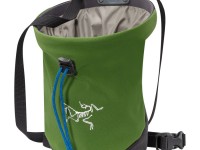 10. Chalk bag– not a necessary component but something that a lot of climbers use, having a good chalk bag to store chalk in a readily accessible place will help with those sweating palms.
10. Chalk bag– not a necessary component but something that a lot of climbers use, having a good chalk bag to store chalk in a readily accessible place will help with those sweating palms.
We hope that this info has helped you. If you have any additional items you want to add to the list or have any questions regarding gear advice to use in certain situations or want recommendations from James and the rest of the OWA gang, please stop by the OWA facebook page and chat us up. We love talking about this stuff.






